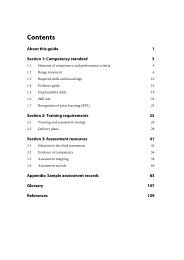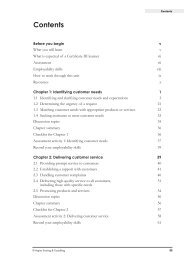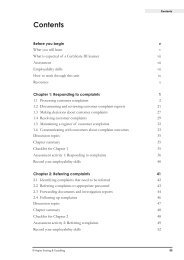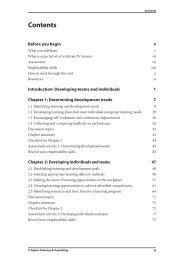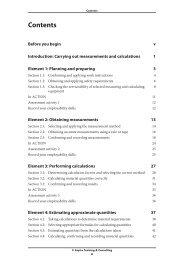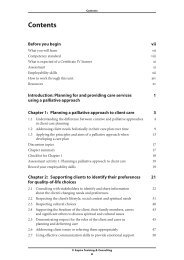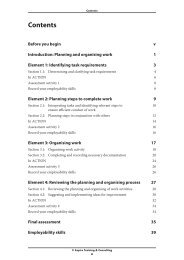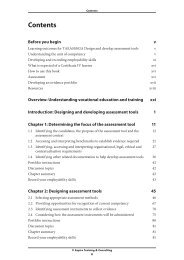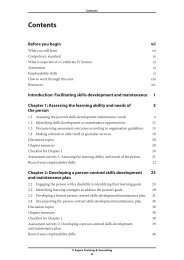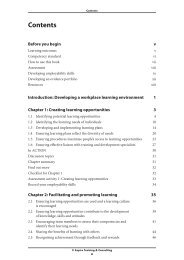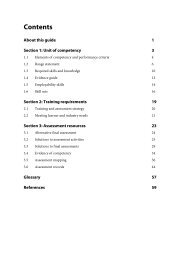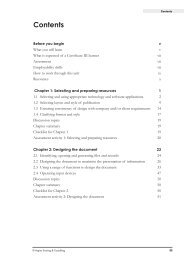Contents - Aspire Learning Resources
Contents - Aspire Learning Resources
Contents - Aspire Learning Resources
You also want an ePaper? Increase the reach of your titles
YUMPU automatically turns print PDFs into web optimized ePapers that Google loves.
<strong>Contents</strong><br />
About this guide 1<br />
Section 1: Competency standard 3<br />
1.1 Elements of competency and performance criteria 4<br />
1.2 Range statement 6<br />
1.3 Essential knowledge and skills 8<br />
1.4 Evidence guide 11<br />
1.5 Employability skills 13<br />
1.6 Skill sets 15<br />
1.7 Recognition process 16<br />
Section 2: Training requirements 17<br />
2.1 Training and assessment strategy 18<br />
2.2 Delivery plans 20<br />
Section 3: Assessment resources 27<br />
3.1 Alternative final assessment 28<br />
3.2 Solutions to assessment activities 30<br />
3.3 Solutions to final assessments 41<br />
3.4 Evidence of competency 47<br />
3.5 Assessment mapping 49<br />
3.6 Assessment records 60<br />
Appendix:<br />
Sample assessment records 79<br />
Glossary 107<br />
References 111
About this guide<br />
This guide is for trainers and assessors of unit CHCAC317A Support older people to<br />
maintain their independence. It complements the corresponding <strong>Aspire</strong> learner<br />
workbook.<br />
As a trainer, you must develop and use training and assessment strategies that embrace<br />
the learner’s needs, educational background, preferred learning style and meet the<br />
requirements of the training package.<br />
This guide provides ideas on how you can encourage and support learners through the<br />
training and assessment process. It is designed to optimise the learner’s experience of<br />
CHCAC317A Support older people to maintain their independence and record details of<br />
their competency.<br />
The guide is divided into six sections:<br />
Section 1:<br />
Section 2:<br />
Section 3:<br />
Appendix:<br />
Glossary<br />
References<br />
Competency standard<br />
Training requirements<br />
Assessment resources<br />
Sample assessment records<br />
How to use <strong>Aspire</strong>’s learner workbooks<br />
<strong>Aspire</strong>’s learner workbooks are structured to meet the requirements of the unit of<br />
competency. The learner workbook’s preliminary pages include:<br />
• information on the unit of competency<br />
• learning outcomes required for Certificate III learners<br />
• assessment information<br />
• employability skills information<br />
• additional learning resources.<br />
Each chapter matches an element in the unit of competency. Chapters are in plain English<br />
so they are easy for the learner to understand. The section headings within each chapter<br />
match the performance criteria.<br />
© <strong>Aspire</strong> Training & Consulting 1
The workbook content describes procedures and current industry practice and includes<br />
examples, checklists, documents, images and real-life case studies. There are also<br />
illustrations or diagrams to add interest and aid learning.<br />
The workbook practice tasks and assessment activities consolidate learning. It is up to you<br />
and the learner to decide which ones are necessary. Remember, these tasks and activities<br />
are not finite. You can add to them, change them or substitute your own tasks according<br />
to the interest level, the experience of the learners and the specific situation.<br />
As the trainer, you are in the best position to judge the full training and assessment<br />
requirements of a unit of competency. The judgments that you make in this regard<br />
should form part of your broader training and assessment strategy.<br />
The workbook discussion topics in each chapter encourage learners to think broadly<br />
about issues, discuss their opinions and listen to ideas from others. The chapter<br />
summaries provide an opportunity to review the chapter content.<br />
Self-assessment checklists are provided at the end of each chapter. When learners have<br />
completed a chapter, help them to complete the checklist to identify anything they don’t<br />
understand. If the learner is unable to complete the checklist, this would suggest that<br />
revision and further training may be needed.<br />
As a trainer, you should encourage classroom learners to observe a real working<br />
environment and discuss what they have seen. You should encourage learners to keep<br />
their answers to activities as these will build towards their evidence and demonstration of<br />
competency.<br />
Learners may or may not be employed in the workplace. Where a learner is currently<br />
employed, trainers should endeavour to use relevant workplace documents and resources.<br />
Where learners are not currently employed, trainers must provide example<br />
documentation and a simulated environment wherever possible.<br />
2 © <strong>Aspire</strong> Training & Consulting
Section 1:<br />
Competency standard<br />
The CHC08 Community Services Training Package was developed by the Community<br />
Services and Health Industry Skills Council in consultation with industry stakeholders<br />
including employers, unions, peak bodies, professional associations, regulatory bodies,<br />
registered training organisations (RTOs) and other relevant parties. The training package<br />
specifies the skills and knowledge required to perform effectively in the workplace.<br />
Individual units of competency are nationally agreed statements that describe work<br />
outcomes and can stand alone when applied in the workplace.<br />
This section outlines the requirements of the unit of competency for CHCAC317A<br />
Support older people to maintain their independence.<br />
Section one contains the following information:<br />
1.1 Elements of competency and performance criteria<br />
1.2 Range statement<br />
1.3 Essential knowledge and skills<br />
1.4 Evidence guide<br />
1.5 Employability skills<br />
1.6 Skill sets<br />
1.7 Recognition assessment<br />
© <strong>Aspire</strong> Training & Consulting 3
1.1 Elements of competency and performance<br />
criteria<br />
The elements of competency define the skills required to perform a work activity. They<br />
describe the required outcomes that need to be assessed.<br />
The performance criteria define the level of skill necessary to achieve the requirements of<br />
the element.<br />
The following table maps the content in the <strong>Aspire</strong> CHCAC317A Support older people to<br />
maintain their independence workbook to the unit of competency.<br />
CHCAC317A Support older people to<br />
maintain their independence<br />
Element 1: Support the older person<br />
with their activities of living<br />
1.1 Encourage older people to utilise support<br />
services where appropriate<br />
1.2 Clearly explain the scope of the service to<br />
be provided to the older person and/or<br />
their advocate<br />
1.3 Identify the needs of the older person from<br />
the service delivery plan and from<br />
consultation with a supervisor<br />
1.4 Ensure visits and service delivery<br />
accommodate the older person’s established<br />
routines and customs where possible<br />
1.5 Perform work in a manner that<br />
acknowledges that the services are being<br />
provided in the client’s own home<br />
1.6 Provide services in a manner that enables<br />
the older person to direct the processes<br />
where appropriate<br />
1.7 Provide support/assistance in accordance<br />
with organisation policy, protocols and<br />
procedures<br />
1.8 Demonstrate appropriate use of equipment<br />
to support/assist the older person with<br />
activities of living within work role and<br />
responsibility<br />
Where covered in the<br />
learner workbook<br />
Chapter 1: Support the older person<br />
with their daily activities<br />
1.1 Encouraging older people to get support with<br />
daily living activities<br />
1.2 Explaining the support to be provided to the<br />
older person<br />
1.3 Getting information about the older person’s<br />
support needs<br />
1.4 Making sure services meet the older person’s<br />
routines and customs<br />
1.5 Respecting the older person’s home<br />
1.6 Allowing the older person to direct their own<br />
support<br />
1.7 Following workplace policies and procedures<br />
1.8 Using equipment to help older people with<br />
their daily activities<br />
4 © <strong>Aspire</strong> Training & Consulting
3.5 Assessment mapping<br />
Methods of assessment mapped to the workbook<br />
Assessment methods are the particular techniques used to gather different types of<br />
evidence. The mix of evidence gathered to demonstrate competency is dependent on the<br />
context of the assessment and the background of the candidate.<br />
The following table outlines the different methods of assessment used in the <strong>Aspire</strong><br />
CHCAC317A Support older people to maintain their independence learner workbook.<br />
Methods of assessment<br />
Assessment method<br />
Practice<br />
task<br />
Question/answer 2, 4, 5, 6, 8,<br />
9, 10, 11, 12,<br />
13, 14, 18,<br />
19, 22, 23,<br />
24,<br />
Assessment<br />
activity<br />
Activity 1<br />
Part A: Q. 1<br />
Part B: Q. 1, 2<br />
Part C: Q 1, 2<br />
Part E: Q. 1, 2<br />
Activity 2<br />
Part A: Q. 1–4<br />
Part B<br />
Part D<br />
Activity 3<br />
Part A<br />
Part B<br />
Activity 4<br />
Part A<br />
Final<br />
assessment<br />
Part A<br />
Alternative<br />
final<br />
assessment<br />
Observation/demonstration Part A ✓<br />
✓<br />
Case study 2, 3, 7, 16,<br />
17, 20, 25<br />
Activity 1<br />
Part A Q. 2<br />
Part A<br />
✓<br />
Activity 2<br />
Part C Q. 1, 2<br />
Activity 3<br />
Part C Q. 1, 2<br />
© <strong>Aspire</strong> Training & Consulting 49
Role-play 21 Activity 1<br />
Part A Q. 3<br />
Part D<br />
Activity 3<br />
Part C Q. 3<br />
Activity 4<br />
Part B<br />
Training log, diary or<br />
journal<br />
Portfolio, reports, work<br />
samples<br />
Third-party reports<br />
1 Activity 3<br />
Part D 2<br />
Part A<br />
50 © <strong>Aspire</strong> Training & Consulting
Elements and performance criteria mapped to the workbook<br />
The following tables map the assessment activities contained in the <strong>Aspire</strong> CHCAC317A<br />
Support older people to maintain their independence learner workbook to the elements<br />
and performance criteria outlined in the unit of competency.<br />
Assessment activity 1<br />
Part Element Performance criteria<br />
A 1 1.1, 1.2<br />
B 1 1.3<br />
C 1 1.4, 1.5<br />
D 1 1.6<br />
E 1 1.7, 1.8<br />
Assessment activity 2<br />
Part Element Performance criteria<br />
A 2 2.1<br />
B 2 2.2<br />
C 2 2.3<br />
D 2 2.4<br />
© <strong>Aspire</strong> Training & Consulting 51
References<br />
Australian Government Department of Education, Science and Training 2008, CHC08<br />
Community Services Training Package, Community Services and Health Industry Skills<br />
Council Ltd, Surry Hills, NSW.<br />
Australian National Training Authority (ANTA) 2001, Training package assessment<br />
materials kit, Department of Education and Youth Affairs, Melbourne.<br />
Charles Darwin University 2009, ‘Assessment VET’,<br />
http://learnline.cdu.edu.au/t4l/teachinglearning/assessmentvet.html#validation.<br />
CSHTA 2008, ‘Competency recognition workshop’, CS&H Industry Skills Council,<br />
Strawberry Hills NSW 2012.<br />
National Quality Council 2007, AQTF 2007 Users’ guide to essential standards for<br />
registration, Department of Education, Employment and Workplace Relations, Canberra.<br />
Voc Ed <strong>Learning</strong> Group 2009, ‘The A-Z of planning and mapping assessment workshop’,<br />
Melbourne, Victoria.<br />
© <strong>Aspire</strong> Training & Consulting 111



